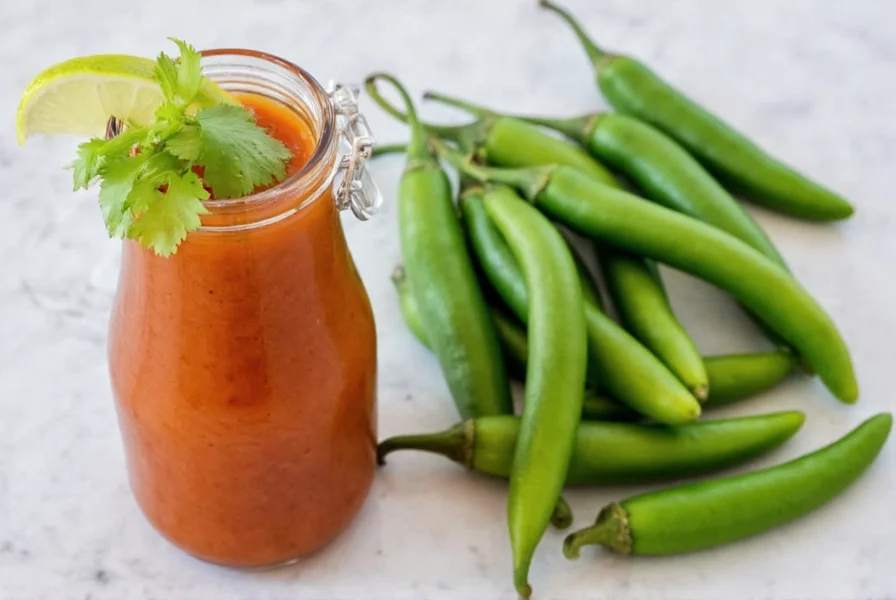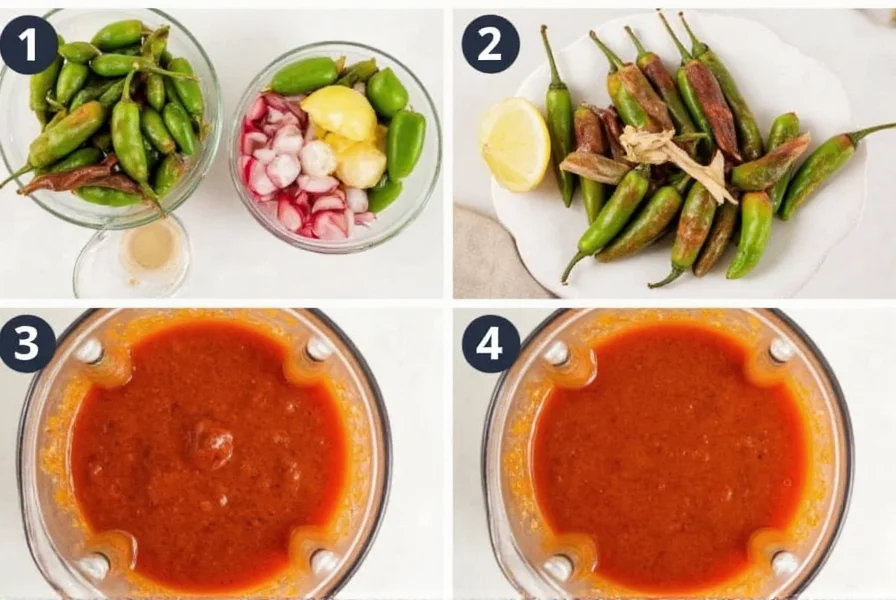Serrano pepper sauce has become a staple in kitchens seeking authentic Mexican flavors with controlled heat. Unlike mass-produced hot sauces that often mask the pepper's natural characteristics, quality serrano sauce preserves the pepper's bright, vegetal notes while delivering consistent spiciness. Understanding its unique properties helps home cooks and culinary professionals maximize its potential in everyday cooking.
Understanding Serrano Pepper Sauce Characteristics
The serrano pepper (Capsicum annuum) originates from the mountainous regions of Mexico, where "serrano" translates to "from the mountains." This heritage influences both the pepper's flavor profile and the resulting sauce's characteristics. When properly prepared, serrano pepper sauce offers a clean heat that builds gradually without overwhelming other flavors.
| Pepper Type | Scoville Heat Units | Flavor Profile | Best Sauce Applications |
|---|---|---|---|
| Serrano | 10,000-23,000 | Grassy, bright, clean heat | Tacos, ceviche, marinades |
| Jalapeño | 2,500-8,000 | Earthy, slightly sweet | Salsas, nachos, dips |
| Habanero | 100,000-350,000 | Fruity, floral, intense heat | Caribbean dishes, hot sauces |
Serrano vs. Jalapeño Sauce: Key Differences
Many home cooks confuse serrano pepper sauce with its milder cousin, jalapeño sauce. The primary distinction lies in heat intensity and flavor complexity. Serrano peppers contain approximately three times more capsaicin than jalapeños, resulting in noticeably more pronounced heat. However, serrano sauce maintains a cleaner, more vegetal flavor profile compared to jalapeño's earthier notes.
When substituting between these sauces, consider the dish's other components. Serrano pepper sauce works best in recipes where you want the heat to shine through without competing with smoky or roasted flavors. Its brighter profile complements seafood, poultry, and fresh vegetable dishes exceptionally well.

Optimal Culinary Applications
Serrano pepper sauce excels in applications where you want controlled heat without overwhelming other ingredients. Professional chefs particularly value it for:
- Tacos and street food - A few drops enhance carne asada or fish tacos without drowning the main ingredients
- Breakfast dishes - Perfect for huevos rancheros or scrambled eggs where consistent heat matters
- Marinades - The vinegar base helps tenderize proteins while adding flavor
- Ceviche and seafood - Complements citrus-based preparations without competing flavors
Unlike fermented hot sauces that develop complex flavors over time, fresh serrano pepper sauce delivers immediate, clean heat that works well in dishes served the same day. For best results, add it toward the end of cooking to preserve its bright characteristics.
Creating Quality Homemade Serrano Sauce
While store-bought serrano pepper sauce offers convenience, homemade versions provide superior flavor control. The simplest authentic recipe requires just three ingredients:
- 10-12 fresh serrano peppers (stems removed)
- 1 cup white vinegar or apple cider vinegar
- 1½ teaspoons salt
For enhanced flavor, many chefs add supporting ingredients like garlic, cilantro, or a touch of lime juice. The preparation process significantly affects the final product's character:
- Wash and dry peppers thoroughly
- Remove stems but keep seeds for maximum heat
- Combine all ingredients in a saucepan
- Simmer gently for 10-15 minutes (do not boil)
- Cool slightly, then blend until smooth
- Strain through fine mesh sieve for traditional texture
- Bottle in sterilized glass containers

Properly stored in the refrigerator, homemade serrano pepper sauce maintains peak quality for 4-6 weeks. The vinegar content acts as a natural preservative while enhancing the pepper's flavor development.
Storage and Shelf Life Considerations
Understanding proper storage techniques extends serrano pepper sauce's usability. Commercial products typically remain viable for 6-12 months unopened, while homemade versions last 4-6 weeks refrigerated. Key storage guidelines include:
- Always use clean utensils when handling sauce to prevent contamination
- Store in glass containers rather than plastic to prevent flavor absorption
- Keep refrigerated after opening, even if the label says "refrigeration not required"
- Discard if mold appears or if the sauce develops off odors
The vibrant green color may fade over time, but this doesn't necessarily indicate spoilage. However, significant darkening or separation that doesn't resolve with shaking suggests the sauce has passed its prime.
Nutritional Profile and Health Considerations
Serrano pepper sauce offers more than just heat—it contains beneficial compounds found in chili peppers. A single tablespoon (15ml) typically contains:
- Negligible calories (approximately 5-10)
- Vitamin C (about 15% of daily value)
- Capsaicin (the compound responsible for heat with potential metabolic benefits)
- Antioxidants that support cellular health
While generally safe for most people, those with sensitive digestive systems should consume serrano pepper sauce in moderation. The capsaicin content may trigger discomfort for individuals with conditions like irritable bowel syndrome or acid reflux.
Frequently Asked Questions
How hot is serrano pepper sauce compared to other hot sauces?
Serrano pepper sauce ranges from 10,000-23,000 Scoville Heat Units (SHU), making it significantly hotter than jalapeño sauce (2,500-8,000 SHU) but milder than habanero sauce (100,000-350,000 SHU). It delivers a clean, grassy heat that builds gradually without overwhelming other flavors in a dish.
Can I substitute serrano pepper sauce for jalapeño sauce in recipes?
Yes, but with caution. Since serrano pepper sauce is approximately three times hotter than jalapeño sauce, use about one-third the amount when substituting. For recipes where heat is crucial to the dish's character, consider mixing serrano sauce with a milder alternative to achieve the desired spice level without compromising flavor balance.
Why does my homemade serrano pepper sauce separate?
Separation in homemade serrano pepper sauce occurs naturally due to the lack of commercial stabilizers and emulsifiers. Simply shake the bottle before use to recombine the ingredients. If separation happens frequently, try blending the sauce longer or adding a small amount of xanthan gum (¼ teaspoon per cup) as a natural thickener that helps maintain consistency.
Does cooking affect serrano pepper sauce's heat level?
Cooking serrano pepper sauce can slightly reduce its perceived heat as volatile compounds evaporate, but the capsaicin content remains largely stable. For maximum heat impact, add the sauce toward the end of cooking. If you prefer milder heat, simmering the sauce for 5-10 minutes before incorporating it into dishes will mellow the spiciness while preserving flavor.
How can I reduce the heat of serrano pepper sauce if it's too spicy?
To reduce excessive heat in serrano pepper sauce, mix it with complementary ingredients that counteract spiciness without diluting flavor. Add equal parts plain Greek yogurt, honey, or lime juice to tame the heat while enhancing complexity. For cooked dishes, incorporate dairy products like sour cream or cheese, which contain casein that binds to capsaicin molecules and reduces their effect on taste receptors.











 浙公网安备
33010002000092号
浙公网安备
33010002000092号 浙B2-20120091-4
浙B2-20120091-4